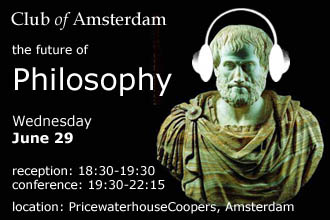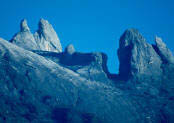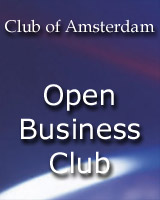
The Culture Industry: Enlightenment as Mass Deception

Theodor W. Adorno
1903-1969

Max Horkheimer
1895-1973
The Culture Industry: Enlightenment as Mass Deception
By Theodor Adorno and Max Horkheimer (1944)Transcribed: by Andy BlundenThe sociological theory that the loss of the support of objectively established religion, the dissolution of the last remnants of pre-capitalism, together with technological and social differentiation or specialisation, have led to cultural chaos is disproved every day; for culture now impresses the same stamp on everything.
Films, radio and magazines make up a system which is uniform as a whole and in every part. Even the aesthetic activities of political opposites are one in their enthusiastic obedience to the rhythm of the iron system. The decorative industrial management buildings and exhibition centers in authoritarian countries are much the same as anywhere else. The huge gleaming towers that shoot up everywhere are outward signs of the ingenious planning of international concerns, toward which the unleashed entrepreneurial system (whose monuments are a mass of gloomy houses and business premises in grimy, spiritless cities) was already hastening. Even now the older houses just outside the concrete city centres look like slums, and the new bungalows on the outskirts are at one with the flimsy structures of world fairs in their praise of technical progress and their built-in demand to be discarded after a short while like empty food cans.
Yet the city housing projects designed to perpetuate the individual as a supposedly independent unit in a small hygienic dwelling make him all the more subservient to his adversary – the absolute power of capitalism. Because the inhabitants, as producers and as consumers, are drawn into the center in search of work and pleasure, all the living units crystallise into well-organised complexes. The striking unity of microcosm and macrocosm presents men with a model of their culture: the false identity of the general and the particular. Under monopoly all mass culture is identical, and the lines of its artificial framework begin to show through. The people at the top are no longer so interested in concealing monopoly: as its violence becomes more open, so its power grows. Movies and radio need no longer pretend to be art. The truth that they are just business is made into an ideology in order to justify the rubbish they deliberately produce. They call themselves industries; and when their directors’ incomes are published, any doubt about the social utility of the finished products is removed.
Interested parties explain the culture industry in technological terms. It is alleged that because millions participate in it, certain reproduction processes are necessary that inevitably require identical needs in innumerable places to be satisfied with identical goods. The technical contrast between the few production centers and the large number of widely dispersed consumption points is said to demand organisation and planning by management. Furthermore, it is claimed that standards were based in the first place on consumers’ needs, and for that reason were accepted with so little resistance. The result is the circle of manipulation and retroactive need in which the unity of the system grows ever stronger. No mention is made of the fact that the basis on which technology acquires power over society is the power of those whose economic hold over society is greatest. A technological rationale is the rationale of domination itself. It is the coercive nature of society alienated from itself. Automobiles, bombs, and movies keep the whole thing together until their leveling element shows its strength in the very wrong which it furthered. It has made the technology of the culture industry no more than the achievement of standardisation and mass production, sacrificing whatever involved a distinction between the logic of the work and that of the social system. […]
But any trace of spontaneity from the public in official broadcasting is controlled and absorbed by talent scouts, studio competitions and official programs of every kind selected by professionals. Talented performers belong to the industry long before it displays them; otherwise they would not be so eager to fit in. The attitude of the public, which ostensibly and actually favours the system of the culture industry, is a part of the system and not an excuse for it. If one branch of art follows the same formula as one with a very different medium and content; if the dramatic intrigue of broadcast soap operas becomes no more than useful material for showing how to master technical problems at both ends of the scale of musical experience – real jazz or a cheap imitation; or if a movement from a Beethoven symphony is crudely “adapted” for a film sound-track in the same way as a Tolstoy novel is garbled in a film script: then the claim that this is done to satisfy the spontaneous wishes of the public is no more than hot air. […]
Today the culture industry has taken over the civilising inheritance of the entrepreneurial and frontier democracy – whose appreciation of intellectual deviations was never very finely attuned. All are free to dance and enjoy themselves, just as they have been free, since the historical neutralisation of religion, to join any of the innumerable sects. But freedom to choose an ideology – since ideology always reflects economic coercion – everywhere proves to be freedom to choose what is always the same. The way in which a girl accepts and keeps the obligatory date, the inflection on the telephone or in the most intimate situation, the choice of words in conversation, and the whole inner life as classified by the now somewhat devalued depth psychology, bear witness to man’s attempt to make himself a proficient apparatus, similar (even in emotions) to the model served up by the culture industry.
The most intimate reactions of human beings have been so thoroughly reified that the idea of anything specific to themselves now persists only as an utterly abstract notion: personality scarcely signifies anything more than shining white teeth and freedom from body odour and emotions. The triumph of advertising in the culture industry is that consumers feel compelled to buy and use its products even though they see through them.
The full article can be read here

News about Philosophy

Guidance for Writing a Code of Ethics
by Chris MacDonald
These suggestions are in no particular order.
1) What will be the purpose of your new code? Is it to regulate behaviour? To inspire?
2) Different kinds of documents serve different purposes. Is your new document intended to guide people or to set out requirements? Is it really a Code of Ethics that you need? You might consider creating a Statement of Values, a Policy, a Mission Statement, a Code of Conduct…
3) A code of ethics should be tailored to the needs and values of your organization.
4) Many ethics codes have two components. First, an aspirational section, often in the preamble, that outlines what the organization aspires to, or the ideals it hopes to live up to. Second, an ethics code will typically list some rules or principles, which members of the organization will be expected to adhere to.
5) Will your new ethics document include some sort of enforcement? If so, what kind?
6) Often the principles or values listed in an ethics document will be listed in rough order of importance to the organization. The ordering need not be strict, but generally the value or principle listed first will have a natural prominence.
7) Think carefully about the process by which you create your new code. Who will be involved? A small working group? Or all the people affected by the code? How will you distil the needs of your organization and the beliefs of your members into a document? The process may matter as much as the final product.
8) How will your new code be implemented? How will it be publicized, both inside and outside of your organization? What steps, if any, will be taken to ensure that the values embodied in your code get implemented in organizational policies and practices?
9) How / when will your code be reviewed / revised?
And remember that a code of ethics will not solve all ethical problems:
“But we must remember that good laws, if they are not obeyed, do not constitute good government. Hence there are two parts of good government; one is the actual obedience of citizens to the laws, the other part is the goodness of the laws which they obey…” (Aristotle, Politics 1294a3-6).

On the Other Hand…
by Joel Marks
Sometimes the greatest enemy of ethics is ‘ethics’
[…]
In effect, the professional ethics movement among businesspersons is what I call the Other Hand Theory, namely, that by conducting business ethically, profit will result (as if by an invisible hand). As noted, there is even a plausible mechanism to account for this, so that this ‘hand’ need not seem mysterious at all, since some level of trust seems obviously necessary to conduct most human affairs, business included.
I will be happy to link arms with professionals who believe that, but I won’t relinquish my ethics credentials to them. For, even apart from the objection of naiveté, I see a deeper flaw in their reasoning. What I have to say parallels comments I made in an earlier column about academic cheating. Ethics is not about rewards. If one does ‘the right thing’ in order to achieve personal gain, then one is not really acting on the basis of integrity.
For example, if you tell the truth only because you think it will benefit you, is that honesty? Obviously not, I would say. My argument: An honest person is precisely one who is committed to truth-telling such that, even if she sees benefit to herself from telling a lie, then, barring extraordinary circumstances, she can be relied on not to tell the lie or deceive either.
Therefore, the kind of ethics that the happy entrepreneur promotes is in a way the enemy of ethics, for the implication is that should there ever arise circumstances when profit would not be maximized by acting morally … too bad for morality!
News about the future

Scientists create artificial cricket hair
Cricket Inspired perCeption and Autonomous Decision Automata.- CICADA
Scientists have re-created one of nature’s most sensitive sound detectors – the tiny hairs found on body parts of crickets, which allow them to hear predators and make an escape before they get close enough to catch them. This research will help scientists understand the complex physics that crickets use to perceive their surroundings and could lead to a new generation of cochlear implants, for people with severe hearing problems, in the far future.
Physicists at the University of Twente in the Netherlands have now succeeded in building artificial sensory hair systems, which they hope will enable them to unravel the underlying process and develop sensor arrays with a variety of important applications.
Marcel Dijkstra, a member of the Twente team, said: “These sensors are the first step towards a variety of exciting applications as well as further scientific exploration. Their small size and low energy consumption make them excellent for application in large sensor networks, whereas there mechanical nature allows for mechanical filtering and parametric amplification. We could use them to visualise airflow on surfaces, such as an aircraft fuselage.”

$2.5 Million Available for Native American Tribes to Develop Renewable Energy Resources
The U. S. Department of Energy (DOE) announced today that it is making nearly $2.5 million available to 18 Native American tribes to advance the use of renewable energy and energy efficient technologies on tribal lands.
“DOE is committed to helping Native American tribes develop their energy resources,” said Secretary of Energy Samuel W. Bodman. “Renewable energy and energy efficiency technologies can play a significant role in encouraging tribal self-sufficiency, creating jobs and improving environmental quality.”
One tribe receiving assistance is the Citizen Potawatomi Nation. Tapping the resources of Fire Lake on their reservation in Central Oklahoma, the tribe will use geothermal ground source heat pumps to provide electricity to community buildings and a grocery store. The tribe, the ninth largest tribe in the U.S. with 1,011 members, will also build a 20-by-96-foot greenhouse using previously wasted heat to grow vegetables to sell in the reservation grocery store.
Next Event: Wednesday, June 29

the future of Philosophy
Wednesday, June 29, 2005
reception: 18:30-19:30, conference: 19:30-22:15
location: PricewaterhouseCoopers, Prins Bernhardplein 200, Amsterdam [next to Amstelstation], free parking.
Huib Schwab: It’s spirituality stupid
John Grüter & Mathijs van Zutphen: VISHandCHIPZ stand-up philosophy
Monica Soeting: Philosophy – a method for returning to reality
Moderator: Homme Heida
eGovernment in the Member States of the European Union
eGovernment in the Member States of the European Union
This report is the compilation of the country Factsheets prepared by the IDABC eGovernment Observatory. As part of its mission to inform the European e-government community about key issues of common interest, the eGovernment Observatory maintains a series of Factsheets presenting the situation and progress of e-government in each Member State of the EU, providing for each one of them a wide and consistent range of information: Country Profile (basic data and Information Society indicators); History (major past e-government developments and milestones); Strategy (vision, objectives and principles supporting the e-government drive); Legal Framework (main legal texts impacting on the development of e-government); Actors (key organisations involved in the e-government drive); ‘Who’s Who’ (main decision-makers and executives steering and shaping the move to e-government); Infrastructure (key components of the nationwide e-government infrastructure); e-services for citizens and for businesses (online availability and sophistication of services for citizens and businesses, based on the eEurope common list of basic public services). This compilation report provides the most extensive sum of information to date on the advancement of e-government in the enlarged EU.
Recommended Book
Philosophers in Conversation: Interviews from the Harvard Review of Philosophy
by Thomas Scanlon, Phineas S. Upham
This volume brings together for the first time thirteen recent interviews with the brightest names in contemporary philosophy, including W.V.O. Quine, Richard Rorty, Stanley Cavell, Hilary Putnam, as well as the only known interview with John Rawls. The pieces are culled from the Harvard Review of Philosophy, which has operated at the core of Harvard’s Philosophy Department since 1991. Covering wide range of topics from the philosophy of law to logic to metaphysics to literature, the interviews provide a fascinating introduction to some of the most influential thinkers of the day. The book also includes an introduction by Thomas Scanlon. Interviews with Henry Alison, Stanley Cavell, Alan Dershowitz, Cora Diamond, Umberto Eco, Harvey C. Mansfield, Jr., Alexander Nehemas, Hilary Putnam, W.V. Quine, John Rawls, Richard Rorty, Michael Sandel, Cornel West
Ecology Asia
| Ecology Asia “Ecology Asia draws attention to the plight of Southeast Asia’s wildlife and degraded environment. In the Eco-news section there’s thousands of cloned news articles, rescued from oblivion and archived by country and category. These articles are used extensively by school and university students for their assignments. Check out Eco-focus for factsheets on hundreds of fascinating species of vertebrate, with all photos taken in natural habitats. And in Eco-location you can read about selected areas rich in fauna and flora.” |
| Some samples: |

Spectacled Langur
The charming Spectacled Langur has dark grey to blackish fur, becoming lighter grey on the crown. The skin on the face is dark grey, the chin and lips pinkish, and the eyes surrounded with a thick white ring. The young are bright yellow. The species occurs in a variety of habitats including coastal and riverine forests. […]

Malayan Soft-shell Turtle
The Malayan Soft-shell Turtle is wide-ranging from Burma, Thailand and Indochina to Peninsular Malaysia, Singapore, Borneo, Sumatra and Java. […]

Mount Kinabalu National Park
At 4101 metres Mount Kinabalu is the highest peak in Southeast Asia (excluding New Guinea), and one of the youngest, having been formed in the last few million years. Its core is formed of hard, silica-rich igneous rocks (mainly granite and granodiorite), however there are significant ultramafic zones (i.e. rock formations low in silica content). The resistance of these rock types to weathering has given rise to a dramatic summit dominated by a series of treacherous, jagged peaks carved during the last ice age around 10,000 years ago. […]
Club of Amsterdam Upcoming Events
| Club of Amsterdam Season 2004/2005 |
| June 29, 2005 | the future of Philosophy |

Club of Amsterdam Open Business Club



Customer Reviews
Thanks for submitting your comment!